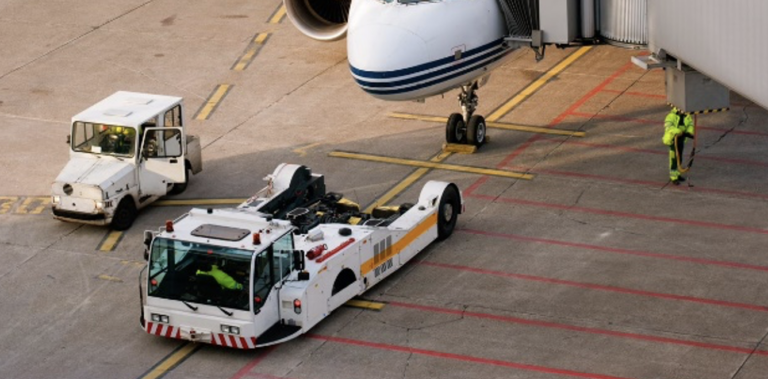With rising pressures from governments across the world, the aviation industry seeking new, innovative ways to reduce carbon emissions and overall environmental impact, including seeking electric solutions for ground support equipment and machinery. Holger Pfriem, manging director, Dafo Asia, and business manager, Dafo Vehicle Fire Protection, explains the fire risks associated with electric ground support equipment and machinery, as well as discussing how those responsible can act to reduce them
***
The electric impact
The aviation industry is actively adopting electric alternatives for all manner of ground support equipment that enables continued air operations – whether that’s push back tractors, transfer buses or refuelers, for example.
This is unquestionably having an impact on the airports’ overall environmental impact. However, it’s also bringing new fire risks into light – which often can’t be effectively addressed using traditional fire detection and suppression solutions.
Many of the electric vehicles (EVs) and machinery used for ground support operations are ‘fuelled’ by lithium-ion (li-ion) batteries. Despite EVs having an arguably lower fire risk than internal combustion engine (ICE) vehicles, the consequences, should a fire occur, are often much more severe.
Typically, there are four main risks associated with li-ion batteries:
- Overcharging or undercharging – where batteries are charged too quickly or battery power is drained too rapidly.
- Mechanical influences or failures – which can arise from a number of factors, such as vehicle collisions, for example.
- Exposure to heat – li-ion batteries are inherently sensitive, which means temperatures need to be regularly monitored and controlled. If EV batteries are close to fire – either in the surrounding area or in another area of the vehicle – they are at much greater risk.
- Production issue – this can result in particles entering li-ion battery cells. Due to the compact nature of these thin cell layers, these particles – no matter how small – can cause significant internal component damage.
Each of these four risks can cause internal short-circuits within li-ion battery cells – which is the primary cause of thermal runaway. Thermal runaway is an extremely dangerous state, which sees rapid temperature increases lead to fire, toxic gas emissions and potentially also large explosions.
These temperature increases are a key sign that thermal runaway is already underway. At this stage, it can be extremely challenging to control or reverse the process.
Before temperatures begin to increase, li-ion batteries emit toxic gases – such as carbon monoxide – as an early indicator that they’re entering thermal runaway. If detected at this point, with the right detection and suppression methods, the process can often be stopped entirely.
Because traditional fire detection and suppression solutions are often only able to detect thermal runaway by identifying rapidly increasing temperatures, there’s an evident need for a unique protection solution. That solution needs to detect toxic gas emissions, before temperatures start to climb.
A much bigger issue…
At airports, thermal runaway poses a much larger threat, as a result of the value of surrounding equipment and aircrafts, as well as the number of passengers being transported across the airport apron at any time.
Ground support equipment and machinery often operates close to airport workers, aircrafts and passengers. This amplifies any fire risk, as the consequences can be significant for people and valuable assets nearby, as well as the surrounding environment. The full extent of the impact of ground support equipment fires is well documented.
Airport operators have a responsibility – and financial need (when considering the costs associated with downtime and equipment damage) – to ensure their ground support equipment and machinery – whether electric or diesel-powered – is safe.
How can airports minimise risk?
Ensuring maximum safety and preventing unnecessary operational downtime begins with understanding your individual risks. That’s not just about considering electrical equipment, but thinking about all equipment and how it operates.
Once you understand the various risks, you can start to develop a tailored fire protection solution, which addresses each of these risks effectively.
When thinking about electrical equipment, you should also take into account:
- How you will ensure electrical equipment is disconnected from charging points when fully charged to prevent overcharging.
- The locations of charging stations, as well as where the power for these is stored – and how that area is protected. Larger battery units storing power for individual vehicles is prone to the same risks, often on a much larger scale.
- Isolation or quarantine protocols for handling damaged EVs, including monitoring solutions that can identify thermal runaway before it leads to rapid temperature increases.
Effectively suppressing your airport’s fire risks is about considering your whole operation – which includes how your vehicles and machinery operate in context. Then, it’s about taking that information and developing a tailored protection solution, which effectively addresses all of the key risks – maximising safety and minimising downtime.





